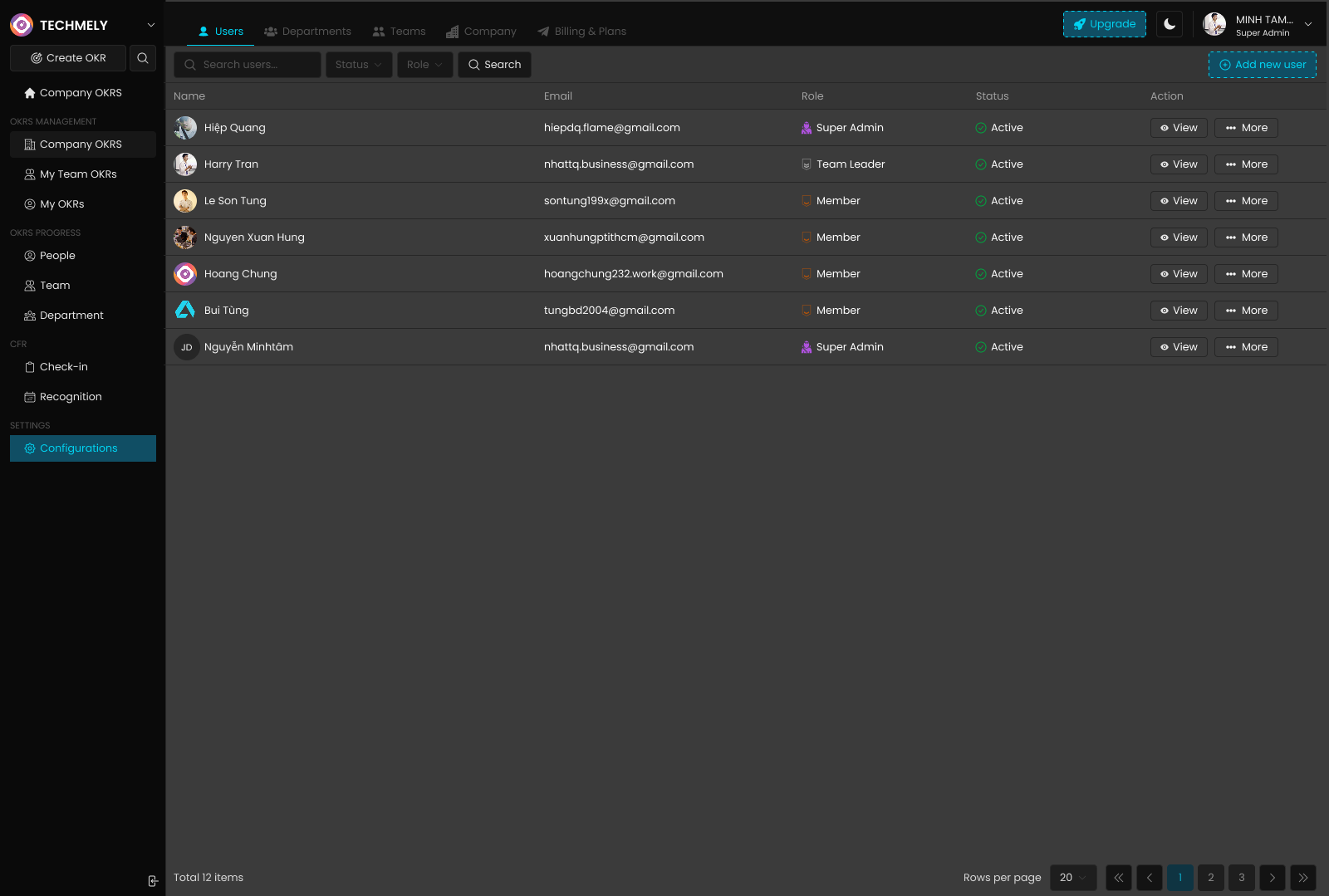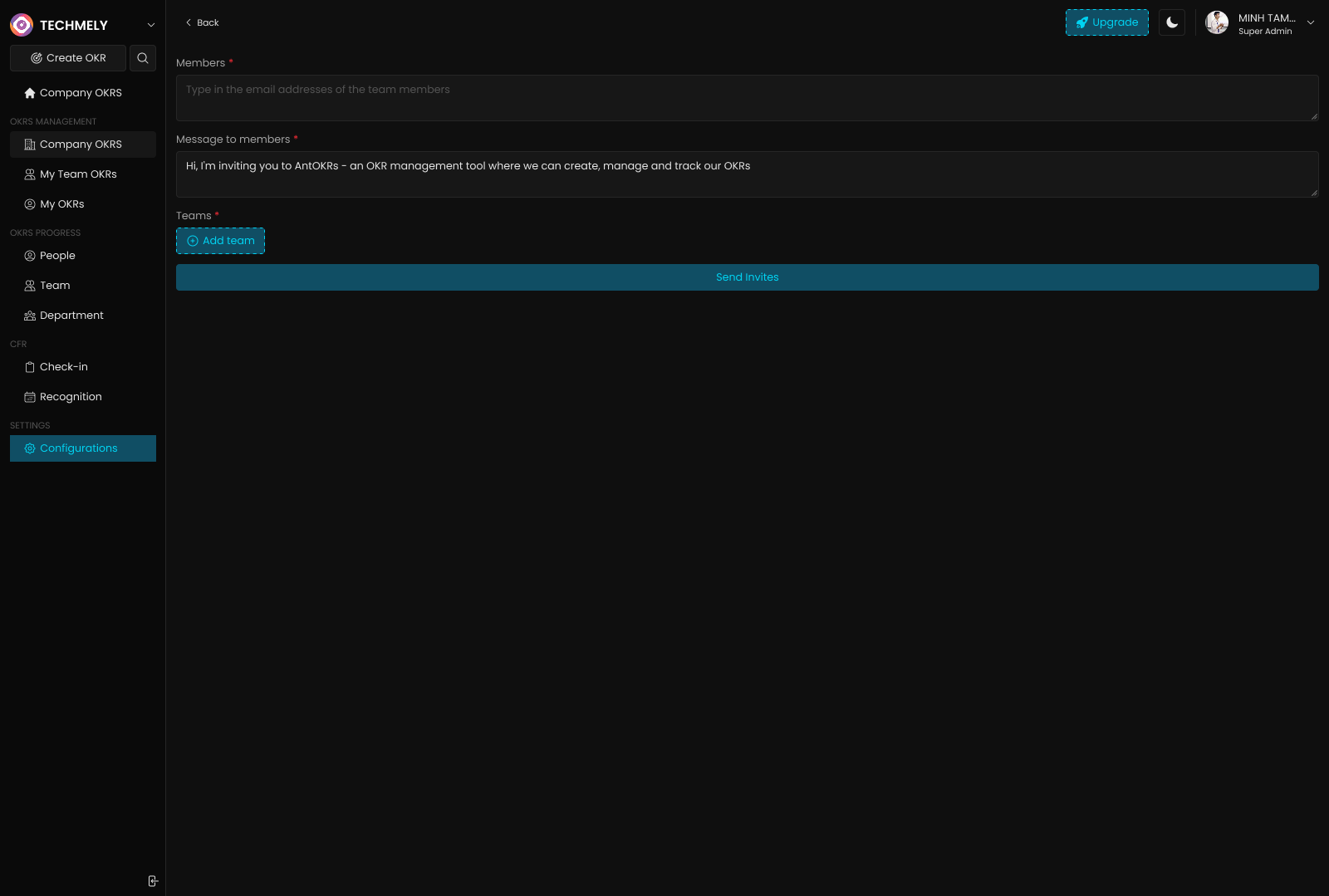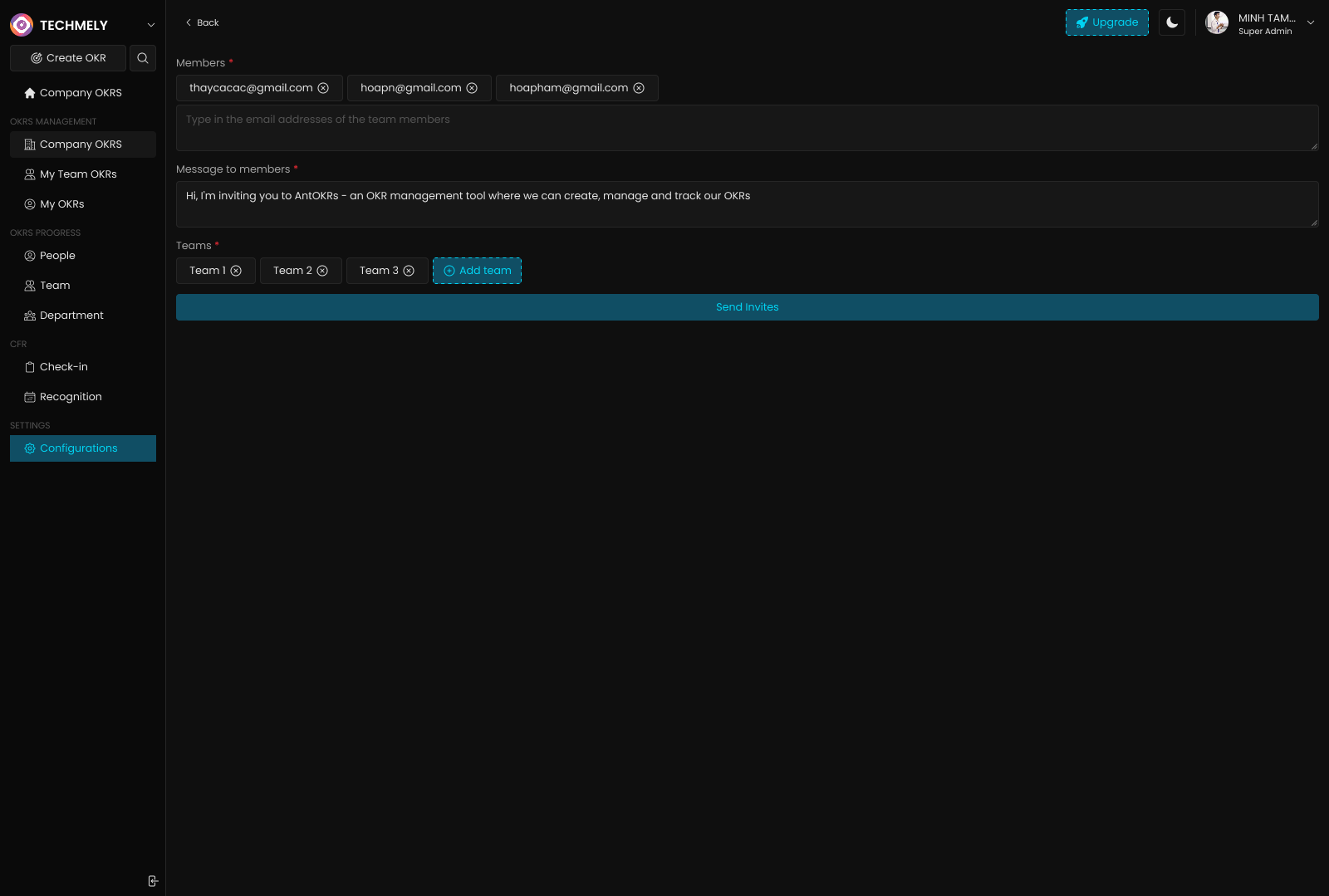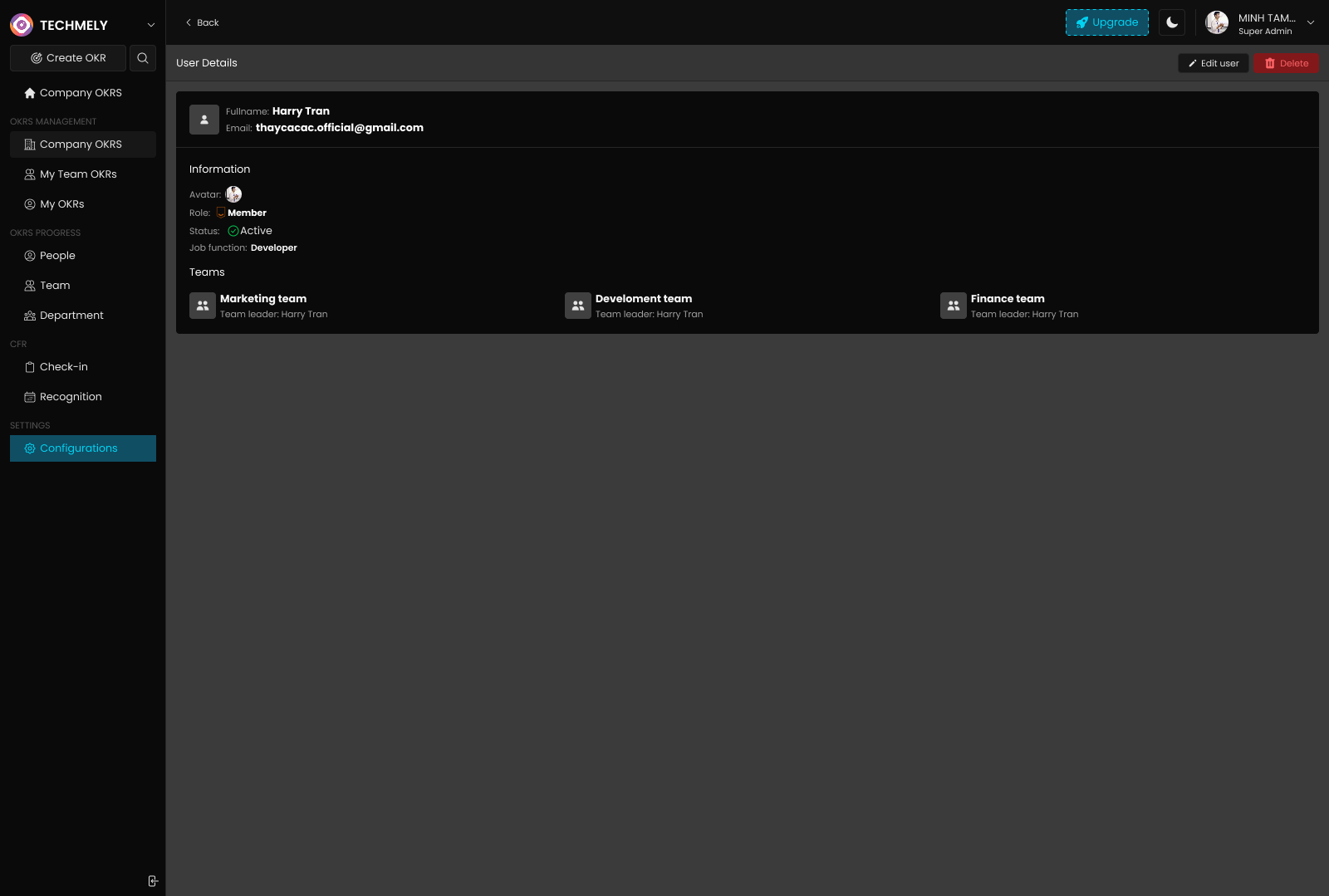Team Management
Complete guide to creating, managing, and organizing teams within your AntOKR organization for effective collaboration and OKR execution
Team Management
Overview
Team Management is the cornerstone of effective organizational structure and collaboration within AntOKR. This comprehensive system enables you to create functional teams, assign team leaders, manage team members, and establish clear hierarchies that support effective OKR implementation and cross-functional collaboration.
Understanding Team Structure
Teams represent the fundamental working units within your organization, bringing together individuals with complementary skills and shared objectives. Effective team management ensures clear accountability, streamlined communication, and aligned efforts toward common goals.
Key Benefits
- Focused Collaboration: Clear team boundaries and shared objectives
- Accountability Structure: Defined leadership and member responsibilities
- OKR Alignment: Team-level objectives that cascade from organizational goals
- Resource Optimization: Efficient allocation of skills and expertise
- Performance Tracking: Comprehensive visibility into team progress and achievements
Team Overview and Management
The team management interface provides complete visibility and control over your organization's team structure, enabling efficient oversight and administration.

Team Management Dashboard
Navigation and Interface:
- Teams Tab: Active view showing comprehensive team overview
- Search Functionality: "Search team" field for quick team discovery
- Search Button: Execute search queries across team database
- Add New Team: Quick access to team creation workflow
Team Information Display:
Data Columns:
- Name: Team identifier with team icon for visual recognition
- Team Leader: Assigned leader with profile picture and name
- Department: Departmental association and organizational structure
- Member: Current team member count and capacity
- Action: Available management operations (View, Edit, Delete)
Current Team Structure Analysis: Based on the interface, the organization currently manages:
- Design Team: Led by Harry Tran, 1 department, 1 member
- AntOKR Marketing Team: Led by Harry Tran, 1 department, 1 member
- Content Creator Team: Led by Harry Tran, 1 department, 1 member
- Kungfutech Dev Team: Led by Harry Tran, 1 department, 1 member
Leadership Analysis:
- Centralized Leadership: Harry Tran leads multiple teams
- Cross-Functional Oversight: Single leader managing diverse functions
- Consistent Management: Unified approach across different team types
- Scalability Considerations: May require distribution as teams grow
Team Management Actions
Available Operations:
- 👁️ View: Access detailed team information, member lists, and performance metrics
- ✏️ Edit: Modify team configuration, leadership, and member assignments
- 🗑️ Delete: Remove team with appropriate safeguards and data handling
Management Best Practices:
- Regular Reviews: Periodic assessment of team structure and performance
- Balance Distribution: Appropriate team sizes and leadership allocation
- Clear Boundaries: Defined team responsibilities and scope
- Performance Monitoring: Track team effectiveness and member satisfaction
Creating a New Team
The team creation process allows you to establish new functional units with proper structure, leadership, and member assignment.

Initial Team Setup
Step 1: Access Team Creation
- Navigate to the Configuration section in the sidebar
- Select Teams from the navigation menu
- Click "Add new team" button to initiate team creation
Step 2: Configure Team Foundation
Team Name:
- Field: "Input team name"
- Requirements: Clear, descriptive team identifier
- Best Practices:
- Use functional or project-based naming (e.g., "Development Team", "Marketing Team")
- Avoid abbreviations that might be confusing
- Consider future scalability and organizational growth
- Maintain consistency with existing naming conventions
Team Leader Selection:
- Field: "Select team leader"
- Purpose: Assign primary leadership responsibility
- Considerations:
- Choose leaders with appropriate skills and experience
- Ensure leader availability and capacity
- Consider cross-team coordination needs
- Plan for leadership development and succession
Department Assignment:
- Field: "Select department"
- Function: Establish organizational hierarchy and reporting structure
- Benefits:
- Clear departmental alignment
- Resource allocation efficiency
- Strategic coordination
- Performance tracking and reporting
Member Management:
- Section: Member assignment area
- Initial State: Empty with "Add member" option
- Functionality: Add team members during creation or later
- Flexibility: Dynamic member management as needs evolve
Team Creation Workflow
Step 3: Complete Basic Configuration
- Enter descriptive team name in the required field
- Leave team leader selection for later assignment
- Skip department assignment if structure is still developing
- Proceed without members for initial setup
Step 4: Finalize Team Creation
- Review all entered information for accuracy
- Click "Create Team" to establish the new team
- Verify team appears in the team management list
- Plan for subsequent configuration and member assignment
Advanced Team Configuration
Teams can be fully configured with complete leadership, departmental alignment, and member assignment for operational effectiveness.

Comprehensive Team Setup
Complete Configuration Example:
Team Identity:
- Team Name: "Development Team"
- Purpose: Clear functional designation
- Scope: Well-defined team responsibilities
Leadership Assignment:
- Team Leader: Harry Tran (with profile picture)
- Leadership Visibility: Clear identification of team leader
- Accountability: Defined responsibility structure
- Communication: Primary point of contact for team coordination
Departmental Integration:
- Department: Harry Tran (department assignment)
- Organizational Structure: Clear hierarchical placement
- Resource Alignment: Departmental resource allocation
- Strategic Coordination: Alignment with departmental objectives
Team Membership:
- Current Members: Harry Tran and Flame Do
- Member Profiles: Visual identification with profile pictures and email addresses
- Contact Information:
- Harry Tran: nhattq.business@gmail.com
- Flame Do: hiepdo@gmail.com
- Expansion Capability: "Add member" option for team growth
Advanced Configuration Benefits
Organizational Clarity:
- Clear Structure: Well-defined team hierarchy and reporting lines
- Role Definition: Specific leadership and member responsibilities
- Communication Channels: Established contact points and coordination methods
- Resource Management: Efficient allocation and utilization of team resources
Operational Efficiency:
- Streamlined Processes: Clear workflows and decision-making structures
- Effective Collaboration: Optimized team composition and skill distribution
- Performance Tracking: Comprehensive visibility into team progress and achievements
- Scalability: Structure capable of accommodating team growth and evolution
Team Details and Member Management
Detailed team views provide comprehensive information about team composition, member roles, and organizational structure.

Team Information Panel
Team Overview:
- Team Name: Design Team
- Team Size: 3 members
- Visual Identity: Team icon for easy recognition
- Administrative Controls: Edit team and Delete options
Management Actions:
- ✏️ Edit Team: Modify team configuration, leadership, and structure
- 🗑️ Delete: Remove team with appropriate data handling and member reassignment
Leadership Structure
Team Leader:
- Leader: Harry Tran
- Contact: nhattq.business@gmail.com
- Profile: Visual identification with profile picture
- Responsibilities: Primary team coordination and decision-making authority
Leadership Capabilities:
- Team Coordination: Overall team management and direction
- Resource Allocation: Distribution of tasks and responsibilities
- Performance Management: Team member development and evaluation
- Strategic Alignment: Connection between team objectives and organizational goals
Team Member Composition
Member Distribution: The Design Team shows a comprehensive member structure:
Row 1 Members:
- Harry Tran: nhattq.business@gmail.com
- Harry Tran: nhattq.business@gmail.com
- Harry Tran: nhattq.business@gmail.com
Row 2 Members:
- Harry Tran: nhattq.business@gmail.com
- Harry Tran: nhattq.business@gmail.com
- Harry Tran: nhattq.business@gmail.com
Analysis:
- Member Consistency: All positions currently filled by Harry Tran
- Contact Uniformity: Single email contact across positions
- Structural Foundation: Framework established for diverse member assignment
- Scalability Potential: Structure ready for varied team composition
Team Management Insights
Current Structure Benefits:
- Unified Leadership: Consistent direction and decision-making
- Clear Communication: Single point of contact for coordination
- Simplified Management: Streamlined oversight and administration
- Rapid Decision-Making: Minimal coordination complexity
Future Development Opportunities:
- Diversified Membership: Addition of varied skills and perspectives
- Distributed Expertise: Specialized roles and responsibilities
- Enhanced Collaboration: Cross-functional team composition
- Skill Development: Member growth and capability expansion
Team Roles and Responsibilities
Team Leader Responsibilities
Leadership Functions:
- Strategic Direction: Set team objectives aligned with organizational goals
- Resource Management: Allocate tasks, time, and resources effectively
- Performance Oversight: Monitor progress and provide guidance
- Communication Hub: Facilitate internal team communication and external coordination
- Development Support: Mentor team members and support skill development
Decision-Making Authority:
- Team Operations: Day-to-day operational decisions and prioritization
- Resource Allocation: Distribution of workload and project assignments
- Performance Evaluation: Assessment of team member contributions
- Process Improvement: Implementation of efficiency enhancements
Team Member Responsibilities
Core Responsibilities:
- Task Execution: Complete assigned responsibilities with quality and timeliness
- Collaboration: Work effectively with team members and cross-functional partners
- Communication: Provide regular updates on progress and challenges
- Skill Development: Continuously improve capabilities and expertise
- Team Support: Contribute to overall team success and culture
Collaborative Duties:
- Knowledge Sharing: Share expertise and insights with team members
- Problem Solving: Contribute to resolution of team challenges
- Process Improvement: Suggest and implement workflow enhancements
- Quality Assurance: Maintain high standards in all deliverables
Team Performance and Analytics
Performance Monitoring
Key Performance Indicators:
- OKR Achievement: Progress toward team objectives and key results
- Collaboration Effectiveness: Quality of internal and external partnerships
- Resource Utilization: Efficiency of time and resource allocation
- Member Satisfaction: Team member engagement and development
- Delivery Quality: Standards and consistency of team outputs
Analytics and Reporting:
- Progress Dashboards: Real-time visibility into team performance
- Trend Analysis: Historical patterns and improvement opportunities
- Comparative Metrics: Benchmarking against other teams and standards
- Predictive Insights: Forecasting and capacity planning
Continuous Improvement
Regular Assessment:
- Performance Reviews: Periodic evaluation of team effectiveness
- Process Optimization: Identification and implementation of improvements
- Skill Gap Analysis: Assessment of development needs and opportunities
- Feedback Integration: Incorporation of member and stakeholder input
Development Planning:
- Skill Enhancement: Training and development opportunities
- Cross-Training: Broadening team capabilities and flexibility
- Leadership Development: Preparation for expanded responsibilities
- Career Pathing: Support for individual member growth
Team Integration and Coordination
Cross-Team Collaboration
Inter-Team Coordination:
- Shared Objectives: Alignment on common goals and priorities
- Resource Sharing: Collaborative use of expertise and capabilities
- Communication Protocols: Established channels for coordination
- Conflict Resolution: Processes for addressing competing priorities
Organizational Alignment:
- Strategic Connection: Link between team objectives and company goals
- Departmental Integration: Coordination within departmental structure
- Cross-Functional Projects: Participation in organization-wide initiatives
- Knowledge Transfer: Sharing of insights and best practices
Communication and Workflow
Internal Communication:
- Regular Meetings: Scheduled team coordination and status updates
- Collaboration Tools: Platforms for real-time communication and coordination
- Documentation: Shared knowledge bases and process documentation
- Feedback Mechanisms: Channels for continuous improvement input
External Communication:
- Stakeholder Updates: Regular reporting to leadership and departments
- Client Interaction: Professional representation of team capabilities
- Partner Coordination: Collaboration with external organizations
- Community Engagement: Participation in industry and professional networks
Advanced Team Management Features
Dynamic Team Structure
Flexible Team Composition:
- Project-Based Teams: Temporary teams for specific initiatives
- Cross-Functional Teams: Members from multiple departments
- Virtual Teams: Distributed team members and remote collaboration
- Matrix Teams: Dual reporting relationships and shared resources
Adaptive Management:
- Scalable Structure: Teams that grow and contract based on needs
- Role Flexibility: Members with multiple skills and responsibilities
- Leadership Rotation: Shared leadership and development opportunities
- Skill-Based Assignment: Task allocation based on expertise and availability
Team Analytics and Insights
Performance Dashboards:
- Real-Time Metrics: Current progress and performance indicators
- Historical Trends: Patterns and improvement opportunities
- Comparative Analysis: Benchmarking against standards and peers
- Predictive Analytics: Forecasting and capacity planning
Data-Driven Decisions:
- Resource Optimization: Evidence-based allocation and utilization
- Performance Enhancement: Targeted improvements and interventions
- Risk Management: Early identification and mitigation of challenges
- Strategic Planning: Long-term team development and positioning
Security and Access Management
Team-Level Security
Access Control:
- Team-Specific Permissions: Granular access to team resources and information
- Role-Based Security: Access based on team position and responsibilities
- Project-Specific Access: Temporary permissions for specific initiatives
- Cross-Team Coordination: Controlled access for collaboration needs
Information Management:
- Data Protection: Secure handling of team and project information
- Privacy Controls: Protection of member personal and professional data
- Audit Trails: Complete history of team access and modifications
- Compliance Management: Adherence to organizational and regulatory requirements
Governance and Compliance
Team Governance:
- Policy Compliance: Adherence to organizational standards and procedures
- Ethical Guidelines: Maintenance of professional standards and behavior
- Risk Management: Identification and mitigation of team-related risks
- Quality Assurance: Consistent standards across team outputs and processes
Regulatory Compliance:
- Industry Standards: Compliance with relevant industry regulations
- Data Protection: Adherence to privacy and data security requirements
- Financial Controls: Appropriate handling of budgets and resources
- Reporting Requirements: Timely and accurate compliance reporting
Best Practices for Team Management
Team Formation and Development
Optimal Team Composition:
- Size Optimization: Teams of 5-9 members for effective collaboration
- Skill Diversity: Complementary expertise and capabilities
- Experience Balance: Mix of senior and junior team members
- Cultural Fit: Alignment with team and organizational values
Development Strategies:
- Clear Objectives: Well-defined goals and success criteria
- Role Clarity: Specific responsibilities and expectations
- Communication Standards: Established protocols and channels
- Performance Metrics: Measurable indicators of success
Leadership and Management
Effective Leadership:
- Servant Leadership: Focus on team member development and support
- Collaborative Decision-Making: Inclusive processes and shared ownership
- Clear Communication: Transparent and frequent information sharing
- Adaptive Management: Flexibility to respond to changing needs
Performance Management:
- Regular Feedback: Continuous guidance and development support
- Recognition Programs: Acknowledgment of achievements and contributions
- Professional Development: Opportunities for skill enhancement and growth
- Career Advancement: Clear pathways for progression and expansion
Troubleshooting Common Issues
Team Formation Challenges
Common Problems:
- Role Confusion: Unclear responsibilities and overlapping duties
- Communication Gaps: Inadequate information sharing and coordination
- Resource Conflicts: Competing demands on time and capabilities
- Performance Disparities: Uneven contribution and engagement levels
Solutions and Interventions:
- Role Clarification: Detailed job descriptions and responsibility matrices
- Communication Enhancement: Improved protocols and collaboration tools
- Resource Planning: Better allocation and conflict resolution processes
- Performance Support: Targeted development and improvement programs
Leadership Challenges
Leadership Issues:
- Overextended Leaders: Excessive span of control and responsibility
- Skill Gaps: Insufficient leadership capabilities and experience
- Authority Conflicts: Unclear decision-making authority and accountability
- Development Needs: Limited leadership training and support
Leadership Solutions:
- Capacity Management: Appropriate distribution of leadership responsibilities
- Skill Development: Targeted training and mentoring programs
- Authority Clarification: Clear definition of roles and decision rights
- Support Systems: Resources and tools for effective leadership
Future Team Management Considerations
Scalability and Growth
Organizational Expansion:
- Team Multiplication: Processes for creating new teams efficiently
- Leadership Pipeline: Development of future team leaders
- Knowledge Transfer: Sharing of best practices and lessons learned
- Technology Scaling: Systems capable of supporting growth
Evolution and Adaptation:
- Changing Business Needs: Flexibility to respond to market changes
- Technology Integration: Adoption of new tools and platforms
- Skill Development: Continuous learning and capability enhancement
- Cultural Adaptation: Evolution of team culture and practices
Technology Integration
Digital Collaboration:
- Advanced Platforms: Next-generation collaboration and communication tools
- AI and Automation: Intelligent assistance for team management
- Mobile Integration: Seamless access across devices and locations
- Analytics Enhancement: Deeper insights into team performance and trends
Process Optimization:
- Workflow Automation: Streamlined processes and reduced manual effort
- Real-Time Collaboration: Synchronous and asynchronous teamwork
- Knowledge Management: Centralized access to information and expertise
- Performance Tracking: Automated monitoring and reporting capabilities
Next Steps
After setting up team management:
- Establish Team Structure: Create foundational teams aligned with organizational needs
- Assign Leadership: Identify and develop effective team leaders
- Define Processes: Establish clear workflows and communication protocols
- Monitor Performance: Implement regular assessment and improvement processes
- Plan for Growth: Prepare for team expansion and organizational evolution
Related Topics
- User Management - Managing individual users and permissions
- Department Management - Organizing teams within departments
- Create Team OKR - Setting team-level objectives and key results
- Change OKR Owner - Transferring ownership and accountability
Effective team management creates the foundation for successful OKR implementation, ensuring clear structure, accountability, and collaboration across your entire organization.
Suggested Related Articles
Change OKR Owner
Complete guide to changing ownership of OKRs across different levels with proper permissions and best practices
Company Configuration
Complete guide to configuring and managing your company settings, branding, and organizational preferences in AntOKR
Create Account
Step-by-step guide to create your user account
Department Management
Complete guide to creating, managing, and organizing departments and teams within your AntOKR organization
Create Company
Learn how to set up your company profile in AntOKR with step-by-step instructions
OKR Progress Tracking
Complete guide to tracking and monitoring OKR progress across departments, teams, and individuals with detailed analytics and insights